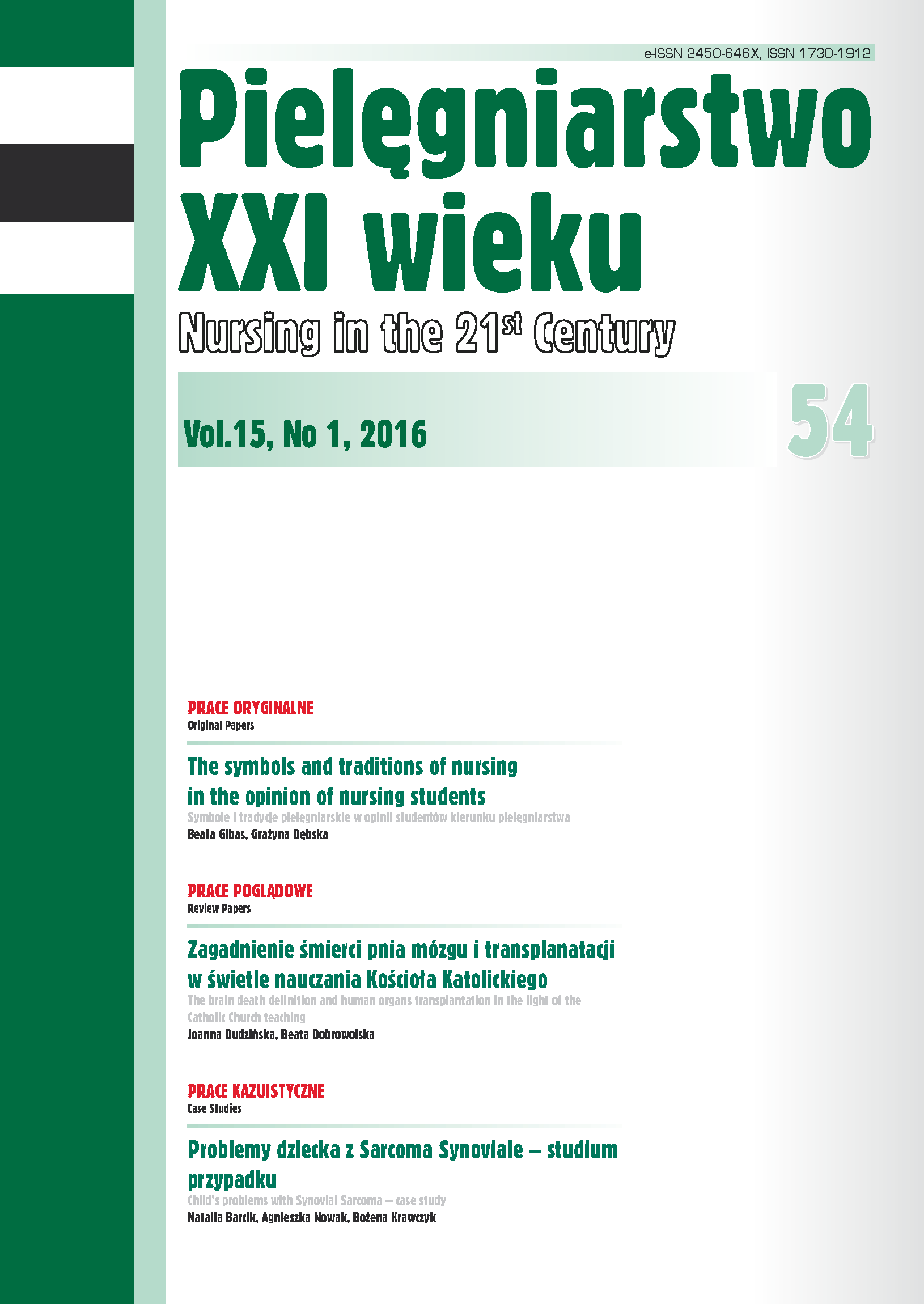Description of selected diagnostic tools in assessing the risk of venous thromboembolic disease
DOI:
https://doi.org/10.1515/pielxxiw-2016-0001Keywords:
diagnostics, risk factors, venous thromboembolic diseaseAbstract
DESCRIPTION OF SELECTED DIAGNOSTIC TOOLS IN ASSESSING THE RISK OF VENOUS THROMBOEMBOLIC DISEASE
Introduction. Deep vein thrombosis (DVT) and its most severe complication, pulmonary embolism (PE) is an interdisciplinary medical problem. Despite a wealth of knowledge, pulmonary embolism is the cause of about 10% of deaths among hospitalized patients and the most common factor which can be prevented. Therefore correct, rapid diagnosis of the patient’s assessment of the risk of sudden death and the quick implementation of treatment are essential to reduce mortality in this disease and prevent its distant complications.
Aim of the study. The aim of this paper is to discuss on the basis of Polish and world literature the selected diagnostic tools in assessing the risk of venous thromboembolic disease.
References
1. Zubilewicz T, Terlecki P. Żylna choroba zakrzepowo-zatorowa. Warszawa: Wyd. Medipage; 2013.
2. Pruszczyk P, Ciurzyński M, Kostrubiec M. Żylna choroba zakrzepowo-zatorowa. Warszawa: Wyd. Medical Tribune; 2012.
3. Fuji T, Fujita S, Ochi T. Fondaparinux prevents venous thromboembolism after joint replacement surgery in Japanese patients. Int Orthop. 2008; 32: 443-451.
4. Szczepański M, Tarnowski W. Zagrożenia żylną chorobą zakrzepowo-zatorową i jej zapobieganie. Postępy Nauk Medycznych. 2012; (25) 1: 69-78.
5. Praca zbiorowa. Polskie Wytyczne Profilaktyki i Leczenia Żylnej Choroby Zakrzepowo-
Zatorowej. Medycyna Praktyczna. Wyd. specjalne. 2012.
6. Dzikowska-Diduch O, Pruszczyk P. Postępowanie w okresie okołozabiegowym u chorego po przebytej ostrej zatorowości płucnej i/lub zakrzepicy żył głębokich. Terapia. 2013; (21) 5: 16-19.
7. Misiak A. Profilaktyka żylnej choroby zakrzepowej u chirurgicznych chorych. Terapia 2002; 4/2: 13-16.
8. Kapitan-Malinowska B, Bogołowska-Stieblich A. Żylna choroba zakrzepowo-zatorowa. Postępy Nauk Medycznych. 2009; 5: 345-354.
9. Julia Hippisley-Cox. Development and validation of risk prediction algorithm (QThrombosis) to estimate future risk of venous thromboembolism: prospective cohort study. BMJ. 2011; 343: 1-12.
10. Zawilska K. Żylna choroba zakrzepowo-zatorowa – postępy 2012/2013. Medycyna Praktyczna. 2013; 9: 60-66.
11. Mikocka-Dybcio E, Jankowski K, Pruszczyk P. Farmakologiczne strategie redukcji ryzyka okołooperacyjnego. Terapia. 2013; 5: 50-55.
12. Rybak Z, Szyber P. Miejsce kompresjoterapii, fizykoterapii oraz farmakoterapii w profilaktyce, leczeniu i utrwalaniu efektów leczenia niewydolności żylnej kończyn dolnych. Terapia. 2000; 8: 27-28.
13. Wells PS, Anderson DR, Bormanis J et al. Application of a diagnostic clinical model for the management of hospitalized patients with suspected deep-vein thrombosis. Thromb. Haemost. 1999; 81: 493-497.
14. Wells PS, Hirsh J, Anderson DR. Accuracy of clinical assessment of deep-vein thrombosis. Lancet. 1995; 345: 1326-1330.
15. Sagripanti A, Carpi A. Natural anticoagulants, aging, and thromboembolism.
Exp Gerontol. 1998;33:891-896.
16. Barbar S, Noventa F, Rossetto V. A risk assessment model for the identification of hospitalized medical patients at risk for venous thromboembolism: The Padua Prediction Score. J Thromb Haemost. 2010;8:2450-2457.
17. Le Gal G et al. Prediction of Pulmonary Embolism in the Emergency Department: the Revised Geneva Score. Ann Intern Med. 2006; 144: 165-171.
18. Camm AJ, Lip GYH, De Caterina R et al. 2012 focused update of the ESC Guidelines for the management of atrial fibrillation. An update of the 2010 ESC Guidelines for the management of atrial fibrillation. Europace. 2012; 14: 1385-1413.
19. Tamariz LJ, Eng J, Segal JB et al. Usefulness of clinical prediction rules for the diagnosis of venous thromboembolism: a systematic review. Am. J. Med. 2004; 117: 676-684.
Downloads
Published
Issue
Section
License
Copyright (c) 2016 Authors

This work is licensed under a Creative Commons Attribution-NonCommercial-NoDerivatives 3.0 Unported License.




